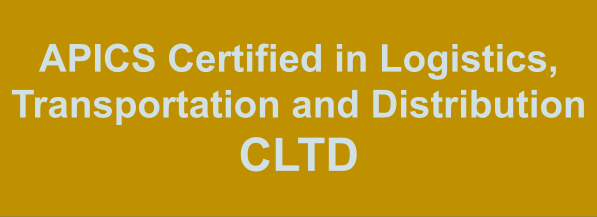Is the CLTD program right for you?
Logistics is top-of-mind for EVERY company delivering products to customers. By earning the Certified in Logistics, Transportation and Distribution (CLTD) designation, you’ll learn best practices along with the latest strategies and trends so you can lead in the logistics, transportation and distribution sectors.
CLTD content covers the following key topics:
◉ Logistics overview and strategy
◉ Logistics network design
◉ Sustainability and reverse logistics
◉ Capacity planning and demand management
◉ Order management
◉ Inventory management
◉ Warehouse management
◉ Global logistics and transportation
CLTD: APICS Certified in Logistics, Transportation and Distribution
APICS CLTD Exam Summary:
| Exam Name | APICS Certified in Logistics, Transportation and Distribution |
| Exam Code | CLTD |
| Exam Fee | PLUS member price - $985 CORE member/nonmember price - $1,315 Retake Fees for Members with Certification - $385 Retake fees Members and Nonmembers - $470 |
| Exam Duration | 210 Minutes |
| Number of Questions | 150 |
| Passing Score | 300 / 350 |
| Format | Multiple Choice Questions |
| Books / Trainings | APICS 2022 CLTD Self-Study Exam Prep |
| Sample Questions | APICS CLTD Exam Sample Questions and Answers |
| Practice Exam | APICS Certified in Logistics, Transportation and Distribution (CLTD) Practice Test |
APICS Certified in Logistics, Transportation and Distribution Syllabus Topics:
| Topic | Details |
| Logistics Overview and Strategy | • Outlining the principles that make logistics useful, including economic drivers • Understanding how logistics fits within supply chain management • Managing logistics strategy, including the logistics value proposition • Developing flexible logistics frameworks and collaborative relationships • Exploring strategic-level risk management • Using fundamental performance measurements and benchmarking • Implementing reengineering and continuous improvement philosophies |
| Logistics Network Design | • Implementing a logistics network design process • Considering transportation requirements driving logistics network plans • Using tools and analyses to select node patterns and links • Adopting risk management • Planning for network security and business continuity |
| Sustainability and Reverse Logistics | • Understanding how logistics plays a key role in demonstrating organizational social responsibility • Managing the triple bottom line, including carbon footprint reductions and green initiatives • Selecting vendors based on sustainable practices • Demonstrating responsibility when handling and managing hazardous and dangerous materials |
| Capacity Planning and Demand Management | • Understanding the basics of forecasting including various types of forecasts • Shaping demand for logistics services • Translating demand information into planning for transportation and warehousing capacity • Providing input during S&OP and participating in collaborative planning, forecasting, and replenishment • Planning for distribution requirements • Managing supply, including ERP master scheduling • Developing a process and selecting a purchasing strategy |
| Order Management | • Performing customer relationship management during order management activities • Implementing CRM to strengthen relationships • Meeting customer needs • Achieving service levels according to customer demand • Managing the process steps and logistics decision points of inbound, intracompany, and outbound order management |
| Inventory Management | • Understanding inventory management, planning, and control • Contrasting stakeholder expectations for inventory management • Summarizing the different functions or purposes inventory serves in a business • Illustrating the major types of inventory costs • Differentiating approaches to safety stock and determinations of when to order • Performing calculations related to standard deviation, economic order quantity, and reorder points • Describing lean, just-in-time, ABC, vendor-managed inventory, and other alternative approaches • Listing common performance metrics |
| Warehouse Management | • Understanding warehousing strategies and determining which to use • Considering physical aspects and tactics related to warehousing design • Exploring warehousing challenges and trends • Summarizing warehouse ownership types and functions • Determining warehouse operations performance measures • Diving deep into warehouse processes, layouts, materials handling, systems and automation, and packaging |
| Transportation | • Outlining transportation fundamentals including cost structure, stakeholders, capabilities, carrier types, mode classifications, and selection considerations • Diving deep into the modes of transportation including road, rail, air, water, pipeline, intermodal, and parcel/courier • Managing transportation according to guiding principles • Considering tradeoffs when designing transportation networks, selecting carriers and modes, and planning routes and schedules |
| Global Logistics Considerations | • Examining current factors in the global logistics space • Staying competitive while balancing cost and level of service • Exploring the history of international trade theories and infrastructure • Discussing global logistics performance indicators and trade specialists • Complying with international trade regulations • Preparing customs documentation • Discussing finance, payment options, terms of sale, payment methods, currency issues, trade zones, and hedging |





0 comments:
Post a Comment